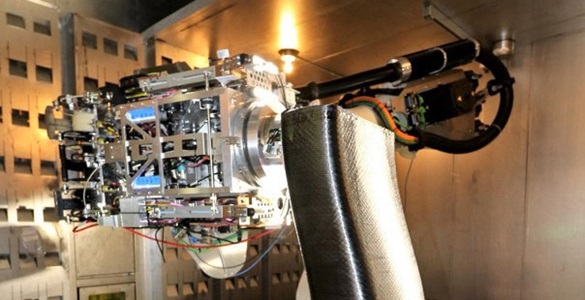SCRAM C/C


Hypersonic Supremacy
As nations around the world race for hypersonic supremacy, Northrop Grumman is perfecting a game changing, rapid fabrication process that produces superior, high-temperature materials at up to half the cost and schedule.
Scalable Composite Robotic Additive Manufacturing Carbon/Carbon (SCRAM C/C) is an industrial robotic 3D printer with the ability to layer continuous fiber-reinforced thermoplastics into components that meet the unique demands of hypersonic vehicles.
“Hypersonic means traveling faster than Mach 5 — or well over 3,000 mph, depending on the altitude — which generates a lot of friction with air molecules,” said Tim Dominick, a Technical Fellow leading the Propulsion Systems and Controls team in Elkton, Maryland, that is developing this technology. “Temperatures can reach thousands of degrees Fahrenheit, and only a few metals can survive at those temperatures — but they are extremely heavy.”
SCRAM C/C technology can be used to create high-temperature materials that do not erode, melt or change shape when exposed to extreme temperatures. They are also lighter than the metals traditionally used, lowering the weight of a hypersonic vehicle and improving performance.
3D printing, often referred to as additive manufacturing, also allows designers to create unique shapes, meaning components that were once multiple pieces bolted or welded together can now be manufactured as one piece.
“We’ve manufactured a part that started with a circular cross section, swept through an S shape and ended in a rectangular cross section,” Dominick said. “That’s an extremely complex geometry that in the past was only possible to create by hand and could take up to a year to make. Now we can make it in a few weeks.”
Godfather of SCRAM
Eric Barnes — an NG Fellow in El Segundo, California, who specializes in additive manufacturing and is often referred to as the Godfather of SCRAM — said the cross-functional teams that originated the idea have continued their fruitful partnership.
“It’s been such a successful collaboration,” he said. “We still meet once a week, we’ve integrated our technical development schedules at both sectors and, more importantly, this has led to some new opportunities. In fact, we’re developing a new proposal right now.”
Jeff Yu, corporate director of technology, said this type of innovation and collaboration is exactly what is needed to advance the technology.
“The race to take hypersonics from the research and development lab bench to practical reality over the next few years is one of the greatest technical challenges for the U.S., and it is one we must win to protect the long-term security of the nation,” said Yu, who represents Northrop Grumman as a member of the University Consortium for Applied Hypersonics, a collaboration between academia, industry and the government sponsored by the U.S. Department of Defense’s Joint Hypersonics Transition Office to advance hypersonic flight systems.
“Our work using SCRAM C/C is an exciting example of different teams coming together to tackle this challenge, using commercial innovations like robotics, additive manufacturing, material science and digital engineering to accelerate our progress,” Yu added.
Dominick said watching this project come to fruition — and exploring all the possibilities for future applications — has been exciting.
“We started out thinking a new technology developed for a different application sounded interesting and wondered if we could apply it to high-temperature materials, which had never been done before,” he said. “And we ended up finding a new use and market for it, with an interest level that’s just exploding.”
“With SCRAM C/C, we are absolutely defining possible.”
Pioneering Scalable Composite Robotic Additive Manufacturing Carbon/Carbon
Media Contact
Anne Eisele
703-996-6658
